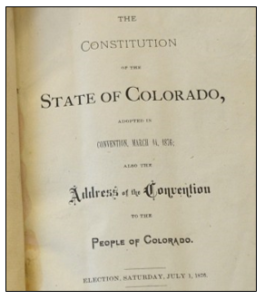by Julie Pelegrin
‘Tis the season. Children are working on their letters to Santa; legislators are working on their bills, diligently meeting with drafters, lobbyists, and stakeholders, trying to craft effective policy to address the state’s issues. Once the policy is worked out, a legislator may figure, “That’s it; all done drafting. Finally I can get that holiday baking done!” But wait – the bill drafter will be pestering legislators with one last question: “Do you want a safety clause or an act-subject-to-petition clause on your bill?”
Here’s a little background information to use in making this important decision.
 When first approved in 1876, the Colorado Constitution placed the legislative power of the state solely in the hands of the elected members of the Colorado House and Senate. And that’s where it stayed for almost 35 years. But by the early twentieth century, many people had become disillusioned with government; they no longer trusted elected officials to act solely in the public interest. The progressive movement arose, and the people started demanding a role for themselves in making the laws. They wanted to put the “demo” back in democracy. At the general election held in 1910, Colorado voters adopted an amendment to the Colorado Constitution—placed on the ballot by the General Assembly—that put the power to make laws directly in the hands of the people through the twin powers of initiative and referendum.
When first approved in 1876, the Colorado Constitution placed the legislative power of the state solely in the hands of the elected members of the Colorado House and Senate. And that’s where it stayed for almost 35 years. But by the early twentieth century, many people had become disillusioned with government; they no longer trusted elected officials to act solely in the public interest. The progressive movement arose, and the people started demanding a role for themselves in making the laws. They wanted to put the “demo” back in democracy. At the general election held in 1910, Colorado voters adopted an amendment to the Colorado Constitution—placed on the ballot by the General Assembly—that put the power to make laws directly in the hands of the people through the twin powers of initiative and referendum.
Using the power of initiative, any individual may propose a change to the constitution or to statute by collecting and submitting to the Secretary of State a sufficient number of signatures on a petition. To place an initiative on the 2022 ballot, an individual must collect at least 124,632 signatures (5% of the total number of votes cast for the office of Secretary of State in the previous general election). The initiative is a positive power, empowering the people to create, change, or repeal law.
In contrast, the referendum power is a negative power, empowering the people only to rescind all or part of an act passed by the General Assembly. By collecting the same number of signatures required for an initiative and submitting those signatures to the Secretary of State, an individual may place all or part of an act on the ballot for the electorate’s approval or disapproval. But the time for rescinding an act is limited; the signatures must be filed with the Secretary of State within 90 days after the end of the legislative session in which the General Assembly passes the act.
There are two exceptions to the power of referendum. The people cannot refer an act to the ballot if: 1) The act is “necessary for the immediate preservation of the public peace, health, or safety”; or 2) the act is an appropriation to support a state agency or institution. Deciding whether an act is an appropriation is relatively straightforward. If all it does is appropriate money, and it does not enact any actual changes to the law, it is likely an appropriation and therefore not subject to the referendum power. But who decides whether an act is necessary for the immediate preservation of the public peace, health, or safety?
The General Assembly does by including what’s called a “safety clause” at the end of the act: “The general assembly hereby finds, determines, and declares that this act is necessary for the immediate preservation of the public peace, health, or safety.”
The Colorado courts have held that the General Assembly alone is authorized to determine whether that declaration is appropriately included in an act. While legislators may certainly debate whether to use a safety clause in a bill, once the General Assembly decides that question, the decision stands; the court will not overturn it. In Van Kleeck v. Ramer in 1916, the Colorado Supreme Court held that, in deciding whether an act is necessary for the immediate preservation of the public peace, health, or safety, the General Assembly “exercises a constitutional power exclusively vested in it, and hence, such declaration is conclusive upon the courts in so far as it abridges the right to invoke the referendum.”
 Deciding whether to include a safety clause in a bill is often a matter of timing. If an act is subject to the power of referendum, because it does not include a safety clause, that act cannot take effect for at least 90 days after the end of the legislative session in which it is passed. As previously explained, a citizen has 90 days after the session ends to collect enough signatures to place the act on the ballot. During that time, rather than risk implementing a law that the voters may reverse, the act is held in limbo; it cannot take effect until the time for collecting signatures expires. And if someone does collect enough signatures to put the act on the ballot, it cannot take effect until the Governor declares the vote after the next general election. General elections occur only in even-numbered years, so if an act passes in a legislative session held in an odd-numbered year and is referred to the ballot by petition, the act won’t take effect—if it even takes effect—until roughly 18 months after the end of the legislative session.
Deciding whether to include a safety clause in a bill is often a matter of timing. If an act is subject to the power of referendum, because it does not include a safety clause, that act cannot take effect for at least 90 days after the end of the legislative session in which it is passed. As previously explained, a citizen has 90 days after the session ends to collect enough signatures to place the act on the ballot. During that time, rather than risk implementing a law that the voters may reverse, the act is held in limbo; it cannot take effect until the time for collecting signatures expires. And if someone does collect enough signatures to put the act on the ballot, it cannot take effect until the Governor declares the vote after the next general election. General elections occur only in even-numbered years, so if an act passes in a legislative session held in an odd-numbered year and is referred to the ballot by petition, the act won’t take effect—if it even takes effect—until roughly 18 months after the end of the legislative session.
The last act referred to the ballot was Senate Bill 19-042, which addressed an agreement among the states to elect the President of the United States by national popular vote. The General Assembly passed the act February 22, 2019, the Governor signed it March 15, 2019, but, because it was referred to the ballot, it did not take effect until December 31, 2020.
In contrast, an act that passes with a safety clause may take effect as soon as the Governor either signs it or allows it to become law without signature.
So if the bill sponsor thinks the bill makes a necessary policy change, and it’s important that the change take effect sooner than 90 days after the end of the legislative session, the bill will need a safety clause.
